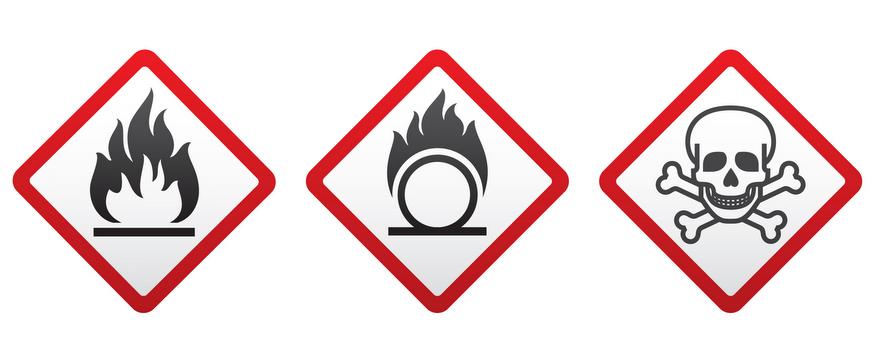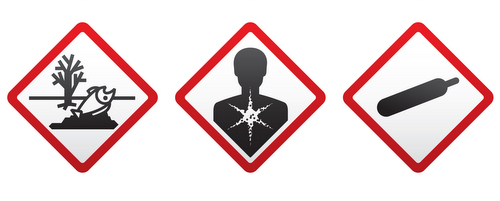
The globally harmonised system (GHS) for hazardous substances provides a common international approach to the classification and labelling of hazardous chemicals (Regulation (EC) No. 1272/2008). There is currently a transitional period during which both the current legislation (the dangerous substances directive and the preparations directive) and the new GHS are in place. The current directives will be repealed on 1 June 2015.
Hazard statements
The new system will replace the existing risk numbers and risk phrases with hazard statements. Hazard statements comprise three-digit numbers. The first digit represents the type of hazard involved; the next two digits are used for detailed classification. For example, the 200 series is for physical hazards, the 300 series for health hazards and the 400 series for environmental hazards.
Hazard classes
The current system of categories of hazardous materials will be replaced by hazard classes, examples of which are shown in the images above and below.

Correlation with new and old systems
For many categories / classes there are direct correlations between the old and new systems. However, this is not the case in all instances, e.g. materials that are classed as acutely hazardous to people. Under the new system, these substances will be categorised according to one of four subdivisions within the acute toxicity hazard class on the basis of laboratory test data. These four categories (numbered 1 to 4) will replace the three categories of acute toxicity under the current system (harmful, toxic and very toxic). However, the old and new classifications do not directly match up on the basis of specific toxicity thresholds.
Implications for COMAH / Seveso facilities
This discontinuity will have implications when the COMAH / Seveso directive and associated regulations are updated, as new threshold quantities will need to be established for these materials. We understand that the authorities are keen to avoid a situation where these changes will result in significant numbers of establishments moving into or out of the COMAH regulatory regime. However, some changes will be unavoidable, and this could impact the status of some COMAH establishments. For example:
- Very toxic materials (T+): the qualifying quantities for some of these materials will increase (e.g. those that fall within category 2 under GHS), which will allow larger quantities to be stored before the COMAH regulations apply.
- Toxic materials (T): the implications do not appear significant in this case, although some materials currently classed as toxic by ingestion may drop out from the COMAH regime.
- Harmful materials (Xn): it appears that some materials currently classed as harmful (by inhalation or skin contact and therefore non-COMAH) will qualify as COMAH materials once the new system is in place, i.e. those that fall within category 3 under GHS.
The transition to GHS will also prompt some changes to the listing of named substances in the COMAH legislation. The most significant of these appears to be for heavy fuel oil (HFO), which will be included as a named substance under petroleum products. This will have the same qualifying quantities as gasoline, kerosene and diesel / gas oil (i.e. 2,500 tonnes for lower tier and 25,000 tonnes for upper tier). The GHS could therefore result in operators of HFO bulk storage facilities being brought into the COMAH regime.
